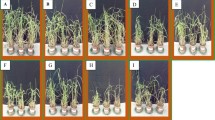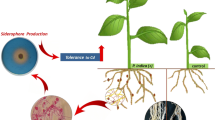Abstract
The growth of hyperaccumulator plants is often compromised by increased toxicity of metals like cadmium (Cd). However, extraction of such metals from the soil can be enhanced by endophytic microbial association. Present study was aimed to elucidate the potential of microbe-assisted Cd phytoextraction in hyperaccumulator Solanum nigrum plants and their interactions under varied Cd concentrations. An endophytic bacteria Serratia sp. RSC-14 was isolated from the roots of S. nigrum. In addition to Cd tolerance up to 4 mM, the RSC-14 exhibited phosphate solubilization and secreted plant growth-promoting phytohormones such as indole-3-acetic acid (54 μg/mL). S. nigrum plants were inoculated with RSC-14 and were grown in different concentrations of Cd (0, 10, and 30 mg Cd kg−1 sand). Results revealed that Cd treatment caused significant cessation in plant growth, biomass, and chlorophyll content, whereas significantly higher malondialdehyde (MDA) and electrolyte production in leaves were observed in a dose-dependent manner. Conversely, RSC-14 inoculation relived the toxic effects of Cd-induced stress by significantly increasing root/shoot growth, biomass production, and chlorophyll content and decreasing MDA and electrolytes contents. Ameliorative effects on host growth were also observed by the regulation of metal-induced oxidative stress enzymes such as catalase, peroxidase, and polyphenol peroxidase. Activities of these enzymes were significantly reduced in RSC-14 inoculated plants as compared to control plants under Cd treatments. The lower activities of stress responsive enzymes suggest modulation of Cd stress by RSC-14. The current findings support the beneficial uses of Serratia sp. RSC-14 in improving the phytoextraction abilities of S. nigrum plants in Cd contamination.



Similar content being viewed by others
References
Abou-Shanab RA et al (2003) Rhizobacterial effects on nickel extraction from soil and uptake by Alyssum murale. New Phytol 158:219–224
Allen RD (1995) Dissection of oxidative stress tolerance using transgenic plants. Plant Physiol 107:1049–1054
Bradford MM (1976) A rapid and sensitive method for the quantitation of microgram quantities of protein utilizing the principle of protein-dye binding. Anal Biochem 72 :248–254
Byers HK, Stackebrandt E, Hayward C, Blackall LL (1998) Molecular investigation of a microbial mat associated with the Great Artesian Basin. FEMS Microbiol Ecol 25:391–403
Chanmugathas P, Bollag JM (1987) Microbial role in immobilization and subsequent mobilization of cadmium in soil suspensions. Soil Sci Soc Am J 51:1184–1191
Chen L et al (2010) Application of plant growth-promoting endophytes (PGPE) isolated from Solanum nigrum L. for phytoextraction of Cd-polluted soils. Appl Soil Ecol 46:383–389
Chen L, Luo S, Li X, Wan Y, Chen J, Liu C (2014) Interaction of Cd-hyperaccumulator Solanum nigrum L. and functional endophyte Pseudomonas sp. Lk9 on soil heavy metals uptake. Soil Biol Biochem 68:300–308
Chirila E, Carazeanu I (2008) Studies about remediation of contaminated soils with toxic metals. In: Simeonov L, Sargsyan V (eds) Soil chemical pollution, risk assessment, remediation and security. NATO science for peace and security series. Springer Netherlands, pp 139−149. doi:10.1007/978-1-4020-8257-3_10
Deb S, Ahmed SF, Basu M (2013) Metal accumulation in cell wall: a possible mechanism of cadmium resistance by Pseudomonas stutzeri. Bull Environ Contam Toxicol 90:323–328
Dickinson NM, Baker AJM, Doronila A, Laidlaw S, Reeves RD (2009) Phytoremediation of inorganics: realism and synergies. Int J Phytorem 11:97–114
Ellman GL (1959) Tissue sulfhydryl groups. Arch Biochem Biophys 82:70–77
Gallego SM et al (2012) Unravelling cadmium toxicity and tolerance in plants: insight into regulatory mechanisms. Environ Exper Bot 83:33–46
Ghosh P, Rathinasabapathi B, Ma LQ (2011) Arsenic-resistant bacteria solubilized arsenic in the growth media and increased growth of arsenic hyperaccumulator Pteris vittata L. Bioresour Technol 102:8756–8761
Gonzalez-Mendoza D, Ceja-Moreno V, Gold-Bouchot G, Escobedo-GraciaMedrano RM, Del-Rio M, Valdés-Lozano D, Zapata-Perez O (2007) The influence of radical architecture on cadmium bioaccumulation in the black mangrove, Avicennia germinans L. Chemosphere 67:330–334
Haferburg G, Kothe E (2007) Microbes and metals: interactions in the environment. J Basic Microbiol 47:453–467
Hallmann J, Quadt-Hallmann A, Mahaffee WF, Kloepper JW (1997) Bacterial endophytes in agricultural crops. Can J Microbiol 43:895–914
Heath RL, Packer L (1968) Photoperoxidation in isolated chloroplasts: I. Kinetics and stoichiometry of fatty acid peroxidation. Arch Biochem Biophys 125:189–198
Hirayama T, Shinozaki K (2010) Research on plant abiotic stress responses in the post-genome era: past, present and future. Plant J Cell Mol Biol 61:1041–1052
Hossain MA, Piyatida P, da Silva JAT, Fujita M (2012) Molecular mechanism of heavy metal toxicity and tolerance in plants: central role of glutathione in detoxification of reactive oxygen species and methylglyoxal and in heavy metal chelation. J Bot 2012:37. doi:10.1155/2012/872875
Khan AL, Waqas M, Hamayun M, Al-Harrasi A, Al-Rawahi A, Lee I-J (2013) Co-synergism of endophyte Penicillium resedanum LK6 with salicylic acid helped Capsicum annuum in biomass recovery and osmotic stress mitigation. BMC Microbiol 13:51
Khan A et al (2014) Phytostabilization and physicochemical responses of Korean ecotype Solanum nigrum L. to cadmium contamination. Water Air Soil Pollut 225:1–11
Lebeau T, Braud A, Jezequel K (2008) Performance of bioaugmentation-assisted phytoextraction applied to metal contaminated soils: a review. Environ Pollut (Barking, Essex : 1987) 153:497–522
Lin YF, Aarts MG (2012) The molecular mechanism of zinc and cadmium stress response in plants. Cell Mol Life Sci 69:3187–3206
Luo S et al (2011) Isolation and characterization of endophytic bacterium LRE07 from cadmium hyperaccumulator Solanum nigrum L. and its potential for remediation. Appl Microbiol Biotechnol 89:1637–1644
Mohamed AA, Castagna A, Ranieri A, Sanita di Toppi L (2012) Cadmium tolerance in Brassica juncea roots and shoots is affected by antioxidant status and phytochelatin biosynthesis. Plant Physiol Biochem 57:15–22
Pitcher DG, Saunders NA, Owen RJ (1989) Rapid extraction of bacterial genomic DNA with guanidium thiocyanate. Lett Appl Microbiol 8:151–156
Rajkumar M, Lee KJ, Lee WH, Banu JR (2005) Growth of Brassica juncea under chromium stress: influence of siderophores and indole 3 acetic acid producing rhizosphere bacteria. J Environ Bio 26:693–699
Ryan RP, Germaine K, Franks A, Ryan DJ, Dowling DN (2008) Bacterial endophytes: recent developments and applications vol 278. vol 1. doi:10.1111/j.1574-6968.2007.00918.x
Sandalio LM, Dalurzo HC, Gomez M, Romero-Puertas MC, del Rio LA (2001) Cadmium-induced changes in the growth and oxidative metabolism of pea plants. J Exper Bot 52:2115–2126
Sanità di Toppi L, Gabbrielli R (1999) Response to cadmium in higher plants. Environ Exper Bot 41:105–130
Sheng XF, Xia JJ, Jiang CY, He LY, Qian M (2008) Characterization of heavy metal-resistant endophytic bacteria from rape (Brassica napus) roots and their potential in promoting the growth and lead accumulation of rape. Environ Pollut (Barking, Essex: 1987) 156:1164–1170
Simmons RW, Pongsakul P, Saiyasitpanich D, Klinphoklap S (2005) Elevated levels of cadmium and zinc in paddy soils and elevated levels of cadmium in rice grain downstream of a zinc mineralized area in Thailand: implications for public health. Environ Geochem Health 27:501–511
Solis-Dominguez FA, Gonzalez-Chavez MC, Carrillo-Gonzalez R, Rodriguez-Vazquez R (2007) Accumulation and localization of cadmium in Echinochloa polystachya grown within a hydroponic system. J Hazardous Mater 141:630–636
Stroiński A (1999) Some physiological and biochemical aspects of plant resistance to cadmium effect. I. Antioxidative system. Acta Physiol Plant 21:175–188
Sun R-L, Zhou Q-X, Sun F-H, Jin C-X (2007) Antioxidative defense and proline/phytochelatin accumulation in a newly discovered Cd-hyperaccumulator, Solanum nigrum L. Environ Exper Bot 60:468–476
Tamura K, Dudley J, Nei M, Kumar S (2007) MEGA4: Molecular Evolutionary Genetics Analysis (MEGA) software version 4.0. Mol Bio Evol 24:1596–1599
Ullah I, Khan A, Park G-S, Lim J-H, Waqas M, Lee I-J, et al. (2013) Analysis of phytohormones and phosphate solubilization in Photorhabdus spp. Food Sci Biotechnol 22:25–31
Wan Y et al (2012) Effect of endophyte-infection on growth parameters and Cd-induced phytotoxicity of Cd-hyperaccumulator Solanum nigrum L. Chemosphere 89:743–750
Wang Z, Zhang Y, Huang Z, Huang L (2008) Antioxidative response of metal-accumulator and non-accumulator plants under cadmium stress. Plant Soil 310:137–149
Wilkins DA (1978) The measurement of tolerance to edaphic factors by means of root growth. New Phytol 80:623–633
Wu SC, Cheung KC, Luo YM, Wong MH (2006) Effects of inoculation of plant growth-promoting rhizobacteria on metal uptake by Brassica juncea. Environ Pollut 140:124–135
Wu H et al (2012) Co-overexpression FIT with AtbHLH38 or AtbHLH39 in Arabidopsis-enhanced cadmium tolerance via increased cadmium sequestration in roots and improved iron homeostasis of shoots. Plant Physiol 158:790–800
Acknowledgments
This research was sponsored by Korea Ministry of Environment as the Eco-Innovation project.
Conflict of interest
The authors declare no potential conflicts of interest.
Compliance with ethical standards
The present research did not involve human participants and/or animals.
Author information
Authors and Affiliations
Corresponding author
Additional information
Responsible editor: Elena Maestri
Electronic supplementary material
Below is the link to the electronic supplementary material.
ESM 1
(DOC 201 kb)
Rights and permissions
About this article
Cite this article
Khan, A.R., Ullah, I., Khan, A.L. et al. Improvement in phytoremediation potential of Solanum nigrum under cadmium contamination through endophytic-assisted Serratia sp. RSC-14 inoculation. Environ Sci Pollut Res 22, 14032–14042 (2015). https://doi.org/10.1007/s11356-015-4647-8
Received:
Accepted:
Published:
Issue Date:
DOI: https://doi.org/10.1007/s11356-015-4647-8




